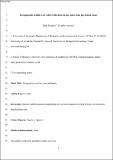Intragenomic conflict over soldier allocation in polyembryonic parasitoid wasps
Abstract
Understanding the selection pressures that have driven the evolution of sterile insect castes has been the focus of decades of intense scientific debate. An amenable empirical testbed for theory on this topic is provided by the sterile soldier caste of polyembryonic parasitoid wasps. The function of these soldiers has been a source of controversy, with two basic hypotheses emerging: the "brood benefit" hypothesis that they provide an overall benefit for their siblings; and the "sex-ratio-conflict" hypothesis that the soldiers mediate a conflict between brothers and sisters, by killing their opposite-sex siblings. Here, we investigate the divergent sex-ratio optima of a female embryo's maternal-origin and paternal-origin genes, to determine the potential for, and direction of, intragenomic conflict over soldiering. We then derive contrasting empirically-testable predictions, concerning the patterns of genomic imprinting that are expected to arise out of this intragenomic conflict, for the brood-benefit versus sex-ratio-conflict hypotheses of soldier function.
Citation
Rautiala , P & Gardner , A 2016 , ' Intragenomic conflict over soldier allocation in polyembryonic parasitoid wasps ' , American Naturalist , vol. 187 , no. 4 . https://doi.org/10.1086/685082
Publication
American Naturalist
Status
Peer reviewed
ISSN
0003-0147Type
Journal article
Collections
Items in the St Andrews Research Repository are protected by copyright, with all rights reserved, unless otherwise indicated.

